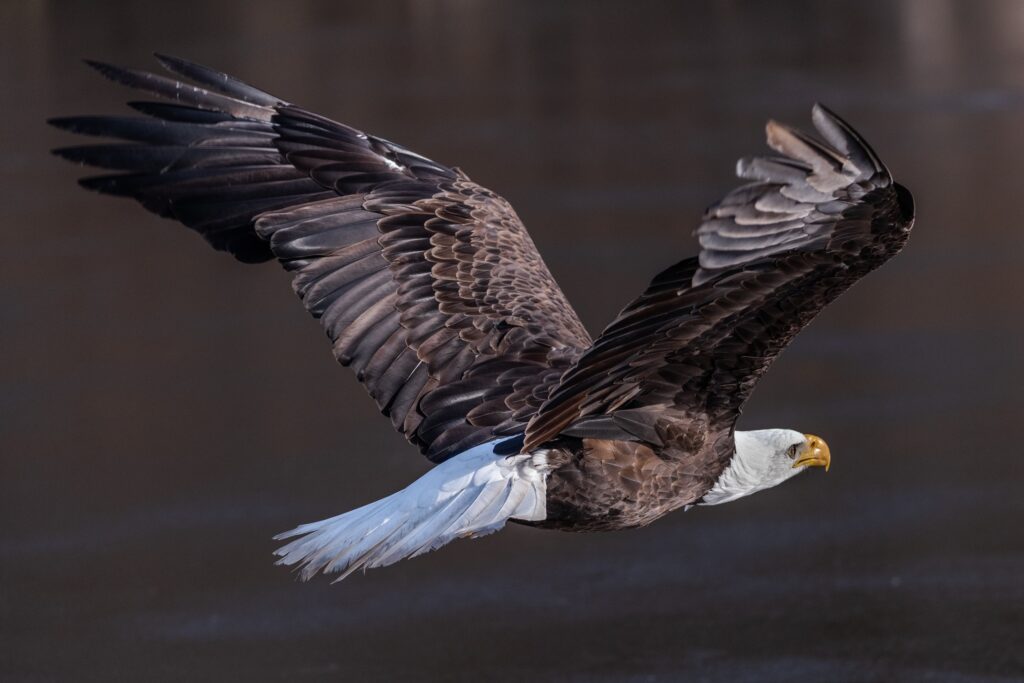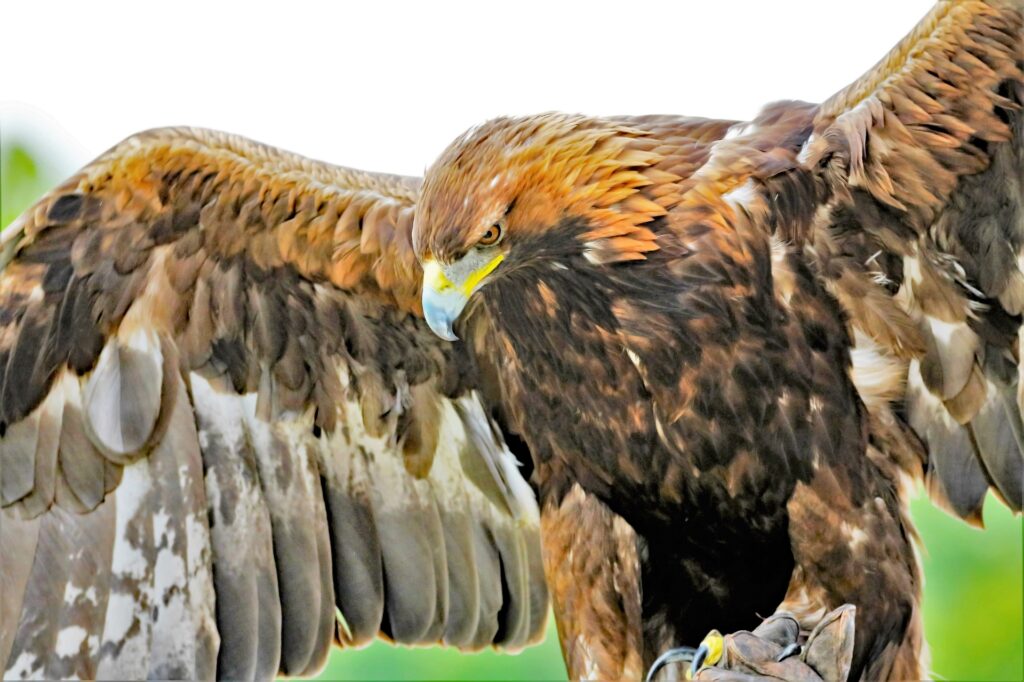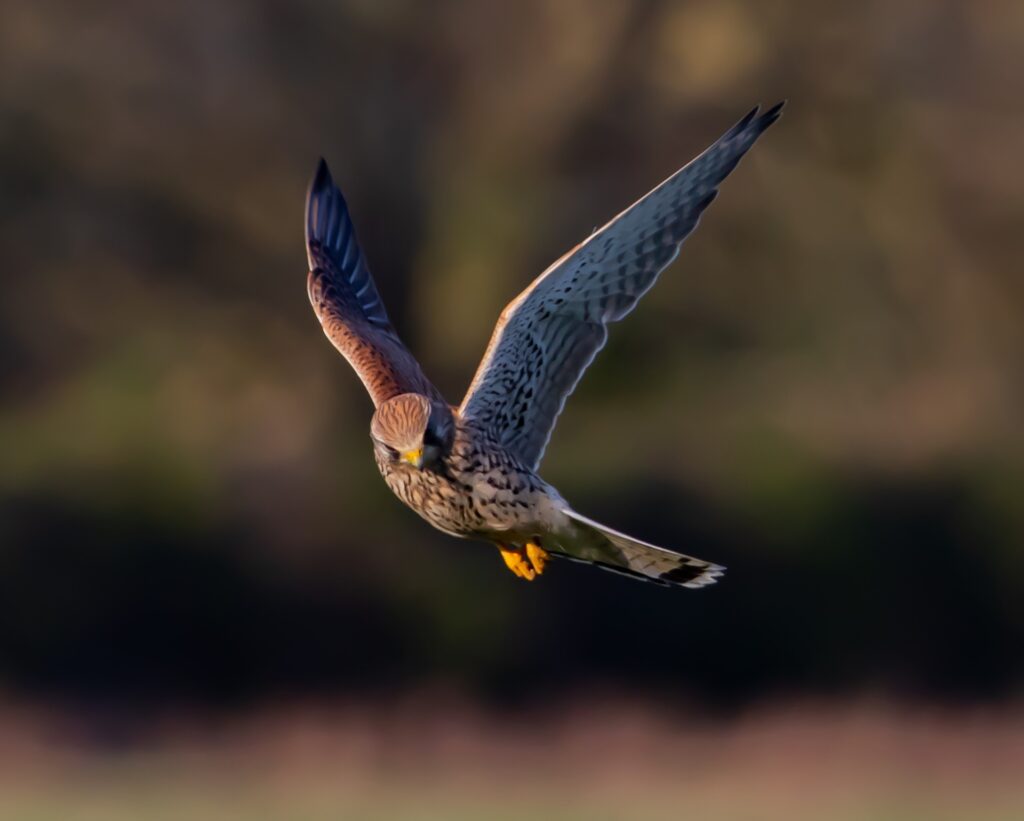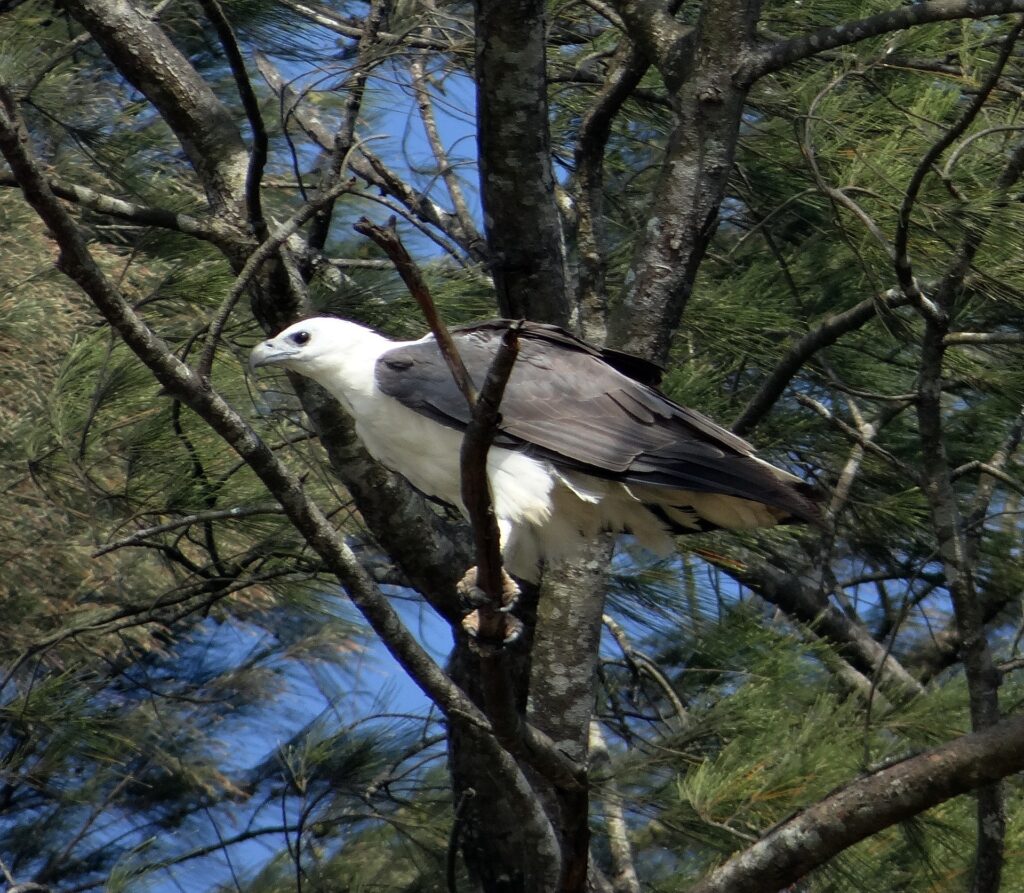An eagle can be briefly described in three words: beauty, majesty, and power.

Eagles are nocturnal birds of prey that belong to the Accipitridae family, along with the vultures of the old world.
They are animals that humans admire, even though some people may find them intimidating, as they are winged predators, elegant, agile, fast, and very silent, even hunting without the victim realizing it is in danger.
In this post, you will learn more about this bird so respected in nature, from what and how they are, their species, habitat, characteristics of eagles, and more.
What exactly is an eagle?

The eagle is the common name for a variety of large predatory birds or raptors belonging to the family Accipitridae or Accipitriformes, formerly known as Falconiformes.
Although they are animals of various genera and there is no universal classification among specialists, when we speak of eagles, we refer to large birds with strong, sharp claws and beaks of robust constitution and predatory habits.
In fact, one of the characteristics of eagles is that they are known as the world’s largest predatory bird, and occur in a variety of species and subspecies that can be found almost anywhere but Antarctica.
Where do eagles live?
It can be found almost anywhere in the world, as long as the climate is not too cold or has extreme temperatures.
Most species inhabit Europe, Asia, and Africa, with only 3 in Australia, 2 in North America, and 9 in the rest of the Americas.
The eagle’s habitat is varied and can be found in mountains, moorlands, grasslands, deserts, swamps, coastal areas, freshwaters, and forests.
Normally, the eagle prefers to roost or rest in high-altitude areas. For example, it can be seen in high branches or clumps of trees, mountain peaks, cliffs, precipices, and ravines.
When winter arrives, some eagles migrate to warmer climates, usually to the south, leaving their main nesting area and moving to a secondary nest that they usually use for this purpose.
On the other hand, other eagles have adapted perfectly to these winters, remaining in the same place for the rest of their lives due to the abundance of food and the ideal temperature.
Types of Eagles
Golden Eagle (Aquila chrysaetos):

they are very famous in the northern hemisphere, belonging to the family Accipitridae.
Despite being banished from some parts of its former habitat, the species is still quite prevalent, being present in Eurasia, North America, and parts of Africa.
Bald Eagle (Haliaeetus leucocephalus):

this is a magnificent bird that flies with elegance, it is found throughout North America, from southern Canada to northern Mexico. The bald eagle is the symbol of strength and freedom in the U.S.
They are not actually bald, as their name indicates; instead, their head is white and their body color varies from light brown to dark brown.
Harpy Eagle (Harpia harpyja):

is a species of neotropical eagle that inhabits jungles and rainforests with tall, well-preserved trees.
It is found from Central America to northern Argentina. It is considered one of the largest and most powerful eagles in existence, as the female is more than 1 meter long and has a wingspan of more than two meters.
The harpy eagle is sometimes referred to as the American harpy eagle, to distinguish it from the Papuan eagle.
Bold Eagle (Aquila audax):
also known as a wedge-tailed eagle. It is the largest bird of prey in Australia and is also found in southern New Guinea.
The Bald eagle lives in a variety of environments but requires tall trees (up to more than 30 meters) for nesting, and in the absence of trees, nests on cliff edges.
Iberian Imperial Eagle (Aquila adalberti):
it is a species endemic to the Iberian Peninsula, and can be found in a variety of habitats, ranging from coastal to mountainous.
As it is a long-lived species, it is currently classified as vulnerable and is protected on the peninsula.
Poma Eagle (Spizaetus isidori):
It is native to South America and its distribution ranges from Venezuela to northwestern Argentina, where it inhabits high Andean forests.
It depends on high-altitude trees for nesting and shelter, which makes the destruction of its natural habitat a serious threat.
Main characteristics of eagles.
Size: it reaches between 70 to 95 cm and weighs from 450 grams. Interestingly, in most birds of prey, males are smaller than females.
The largest eagles have a wing length of more than two meters, while the smallest eagles have a wing length of less than one meter.
Weight: on average, this bird weighs a range of 3 to 5.8 kg. Some weigh less than half a kilo, while others can weigh more than 10 kg.
Wings: They are broad, long, and rectangular, with digitations at the end, which means that the primary feathers separate and look like fingers.
Depending on the species, the wingspan of an eagle can reach astonishing dimensions of more than two meters in length, especially in flight, when it keeps them immobile, firm, like the sails of a boat in a strong wind.
Beak: the beak of eagles is adapted to swallow meat because they are birds of prey. For this reason, it curves downward, forming a hook with a sharp point, and the edges of the beak are more or less grooved, but without forming teeth.
Claws: are among the most powerful that exist in nature, not only can they cause serious damage to their prey, they can also catch them with a strong grip and take flight.
Feathers: they have a variety of layers, the outer ones are the most powerful and give more strength to the flight.
The inner feathers decrease air resistance, allowing them to glide and return to their original position with ease, while the soft down traps the air to keep it warm.
The feathers of its folded wings reach the edge of its tail, something characteristic of the eagle is the plumage on the lower part of its legs.
Tail: it is rounded, with the end facing outward. It is one of the characteristics of eagles that we must look at to distinguish them from each other.
Lifespan: because it has no natural predators, the average lifespan of the bird is between 14 and 25 years. The more voluminous a species is, the longer it lives.
The Eagle’s vision.
Among the characteristics of eagles, something very remarkable is their extraordinary vision. They possess extremely sharp eyesight that allows them to see potential prey at a distance.
Their eyes are slightly larger than human eyes, but they can see almost four times as much and better. They can see prey moving at a distance of 2 kilometers.
The cornea and iris have an opening angle of about 85 degrees and changing their curve results in a very precise accommodation.
The flight of the Eagles.
The size of an eagle’s open wings is more than two meters, and when it flies it keeps them extended, almost immobile, and tries to enjoy the force of the wind when it flies.
The eagle glides like a stork with slight and imperceptible movements of the tail and wings.
To hunt, the golden eagle flies over a hill, releasing the animals into the open air and then flying over them at speeds of up to 150 kilometers per hour.
What Do Eagles Eat?
Eagles are carnivorous animals, feeding mainly on small mammals such as rabbits since they are defenseless and easy to find in the forest, which facilitates hunting.
But, they also feed on mice, marmots, hares, foxes, pigeons, young servals, snakes, and wild boars, and some species of eagles feed on marine animals and even monkeys.
When they are unable to find food, they may resort to eating carrion, although this is the last resort, except for the bald eagle.
Hunting Skills
One of the characteristics of eagles is their fierce and effective hunting. Eagles often use the top of a cliff or a branch high in a tree as a lookout tower to spot prey.
They then swoop down on their prey by extending their large, powerful legs with sharp talons.
When they hunt their victim, they crush it with their feet and claws to kill it, then shred the meat with their large, hooked beak.
Reproduction of Eagles

Eagles are animals that usually have only one mate for the rest of their lives, unless they die too soon, in which case, they will look for another mate in the next mating season.
Like most birds, eagles reproduce by internal fertilization, after copulation. The female then deposits her eggs in a previously constructed nest.
They maintain the same nest year after year, only enlarging it with more branches to a diameter of 1.8 meters and a height of 1.5 meters.
The largest bird nest ever discovered measured more than three meters in diameter and weighed about 2 tons.
The incubation period depends on the size of the eagle; the larger the eagle, the longer the process takes. The female eagle usually lays two or three eggs, although one of them survives.
This is because when the first eaglet hatches, it will feed first, and by the time the second hatches, it will have grown bigger and stronger, stealing the rest of the food, thus decreasing the chances of the other eaglets surviving.
The eaglets are then raised and cared for by both parents until they are ready to fly and leave the nest to start their own lives.
What are the Eagle’s threats?

Other characteristics of eagles are that they have no predators! However, their eaglets can be preyed upon by squirrels, owls, rats, jays, and other animals climbing for food.
Still, as with many animals, many eagle species are in danger of extinction, with humans being the main cause.
The eagle was listed as endangered until 1995 when it was upgraded to “threatened” status.
There are at least 15 endangered eagle species, including the harpy eagle in South America, which, despite major conservation efforts, is losing its habitat due to deforestation.
- Modification of its range
The main threat to this bird is the fragmentation and loss of habitat because of changes in land use for agricultural and livestock activities, as well as urban centers.
- Electrocution
The construction of a power line to bring electricity to the area, which represents a danger to the eagles while flying, as they are prone to die from electrocution when they collide with high-voltage wires.
The imperial eagle, for example, is another of the most endangered birds, especially due to lack of food and power lines. For this reason, many communities struggle to keep this species alive in their environment.
Thanks to this, its population has doubled since the 1990s. There are currently 564 imperial eagles erected in Spain.
- Illegal trafficking
They plunder the nests, stealing the eggs and chicks to trade them in illegal wildlife markets.
- Pesticide
Likewise, the bald eagle, although an emblematic bird in the United States, was on the verge of extinction, as sport hunting of this species was very famous and, in addition, the pesticides that contaminated their fishes.
This accidental consumption of pesticides weakened the shells of their eggs and limited the eagles’ ability to reproduce. In 1972 a law was passed banning the use of these pesticides and the eagle population continued to increase.
What can we do to help Eagles?

The conservation of endangered species is everyone’s business.
Over time, some awareness has been raised about their preservation thanks to organizations such as the American Eagle Foundation and the renowned National Geographic, which have created programs that promote the care of their habitats and the species itself.
You can help by donating to eagle conservation and welfare organizations, as well as notifying state wildlife agencies of any disturbance of eagle habitat or nests by individuals or corporations.
We hope you liked this post about the habitat, feeding, reproduction, and characteristics of eagles. Knowing more about them, and with every contribution, we can conserve this wonderful species together.
Srilankan Eagles
Srilanka is native to many beautiful birds, including eagles. Here is the list of all the common Srilankan Eagles:
1. Black Eagle (Ictinaetus malayensis)
Range: Southern Asia from Sri Lanka and India to Southeast Asia
According to its name, Black Eagles are almost entirely black in color. A golden cere and feet with brown eyes give a fantastic look. Their beak varies in color from yellow to gray, with a black tip. White patches are frequently seen at the base of the primary feathers and on the under tail coverts. The wings are enormous compared to the bird’s body size, with long, extended primary feathers on the under tail coverts. The claws of particular eagles are not as curved as those of others.
The head, neck, back, and wings of juveniles are dark brown, as is the rest of their bodies. A buff-yellow hue speckles their bodies, and a gray bar runs down the length of their tail. The belly and thighs are heavily striped, while the underparts are heavily streaked with black.
2.Common Kestrel (Falco tinnunculus objurgatus)

Range: Sri Lanka, India Nepal, Pakistan
The common kestrel (Falco tinnunculus) is a species of bird of prey that is a member of the kestrel group of the falcon family Falconidae and is found in North America. The European kestrel, Eurasian kestrel, and Old World kestrel are all names for the same bird. In Srilanka, where no other kestrel species is widely seen, it is often referred to as a “kestrel.”
3.Crested Goshawk (Accipiter trivirgatus)

Range: China, India, Srilanka
Accipiter hawks are tiny to medium-sized hawks that are often referred to as Sparrow-hawks or Goshawks. They are found across North America. The females are nearly usually significantly bigger than the males – in some cases weighing twice as much – a level of size dimorphism that is very seldom seen in any other genus Falconiformes and is a rarity in any other animal group. Their wings are small and rounded, and their tails are often very long in length. They are well-suited to flying through thick vegetation. Bird-catching Sparrow-hawks are distinguished by their long and thin legs and slender digits, with the middle digit being particularly long. Goshawks are often more prominent in size, with shorter, thicker tarsi and digits and a shorter middle digit than other raptors. Some smaller species have goshawk-like feet and vice versa, making it impossible to split the genus on a global scale on this or any other broad basis.
4.Crested Hawk-Eagle (Nisaetus cirrhatus ceylanensis)

Range: Sri Lanka (possibly also Travancore)
Depending on the subspecies, crested hawk eagles can be found in various forms, including crested, crestless, dimorphic (having both a pale and a dark morph), and monomorphic (containing only one morph).
Brown wings with black tips and four or five darker bands distinguish dark morph Crested Hawk Eagles from other varieties. The underside of the breast and underside of the undertail is stained with brown, while the undertail and thighs are barred with white. The floppy crest is long and made up of around four feathers. There is a white line down the chin and throat, and the eyes are yellow. The legs are long and feathered, and the long tail bears narrow bars on either side of the body.
5.Crested Serpent Eagle (Spilornis cheela) or Kanmuri-washi
Range: South Asia, from Pakistan to India and Sri Lanka
The Crested Serpent Eagle’s name, cheela, comes from the Hindi word for kite, which means kite. It is fantastic to see this medium-sized bird of prey soar to great heights in the sky, as it is a genuine representation of awe. It may be found in the majority of countries in the Oriental area. In captivity, it has been discovered that the species has a lifespan of up to 50 years.
As the name implies, Crested Serpent Eagles take pleasure in snatching and eating snakes. However, they do not rely only on this for their nutrition since they also hunt small animals and birds. Its ability to soar, along with its exceptional vision, makes hunting a simple chore for this creature. Moments of the species feeding may be observed in various environments, including forests, wetlands, and urban areas.
6.White-bellied Sea Eagle (Haliaeetus leucogaster)

Range: India, Srilanka, and Nepal
It is possible to witness the giant white-bellied sea eagle swooping down to pick fish from Koggala Lake, which is the bird’s normal hunting area in Srilanka. The bird may also be spotted roaming the grounds here at Tri, which is a popular destination for birders. This raptor bird of prey is Sri Lanka’s biggest bird — with a wingspan of up to 2.5m — and is incredibly recognizable due to its white head, under-wing coverts, and a loud, goose-like honking sound when it flies.
Some other Srilankan Eagles are:
·Grey-headed Fish Eagle (Ichthyophaga ichthyaetus)
Range: Breeds in southern Asia from India and Sri Lanka to Southeast Asia
·Indian Peregrine Falcon (Falco peregrinus), commonly known as Black Shaheen or Indian Shaheen
Range: South Asia, from Pakistan to Sri Lanka and southeastern China.
In Sri Lanka, this species prefers higher elevations, whereas the migratory calidus may be found more frequently along the shore and in the lowlands. It is tiny and black in appearance, with rufous underparts banded with a lighter color on the underside.
·Jerdon’s Baza (Aviceda jerdoni)
Range: Terrestrial landscapes include the Terai in northern India and the Eastern Himalayan foothills from Eastern Nepal and the Bengal duars to the Assam valley and the Western Ghats of Southern India and southern Sri Lanka.
·Mountain Hawk-eagles (Nisaetus nipalensis)
Range: Southern Asia from Pakistan, India, and Sri Lanka to China, Taiwan, and Japan
·Pariah Kite / Bird of Prey (Milvus migrans Govinda)
Range: Eastern Pakistan east through tropical Srilanka